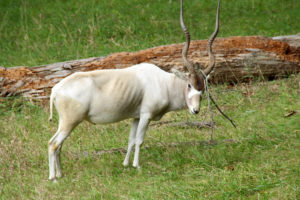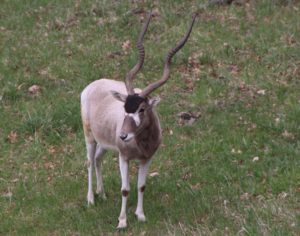ADDAXAddax nasomaculatus
Conservation Status: Critically Endangered
Less than 100 (probably less than 50), almost all in one region of Niger, poaching, and disturbance from humans

Learn More
Color:
Sandy to almost white color during the summer, darkening to a grayish-brown in the winter. White markings on the face, ears, belly, hips, and legs and there is a black tuft of hair on the forehead. Horns present in both males and females.
Size:
60-67 in. (length), 37-45 in. (shoulder height)
Weight:
132 – 276 lbs.
Average Lifespan:
Up to 19 years
Captive Lifespan:
Up to 26 years
Small regions of southeastern Niger, a small region of central Mauritania, a small region of central Chad, possibly a small region of central Niger, and possibly a small region of northwestern Mauritania
Not restricted to areas with free water, usually found within the desert or the surrounding stony country.
Mating:
Throughout the year, most common during the spring
Gestation/Incubation:
257 – 264 days
Litter/Clutch Size:
1 – 2
Mature:
Males at 2 years, females at 2 – 3 years
Desert grasses and scrub. Spend most of their lives without drinking water; receive enough moisture from vegetation to survive.
Diurnal, territorial, and social. Move through desert in herds of 5-20, led by a dominant adult male. Search great distances for sparse vegetation.
1. Droughts, desertification of savanna lands, and increasing human population have all contributed to the decrease of addax populations.
2. Their meat and skin are prized by local people who use the hides for shoes and sandal soles.
3. They are heavily built and slow running, and often die of exhaustion after being chased by tourists in vehicles.





